Annotated Bibliography: Strategic HR in the Retail Industry Context
VerifiedAdded on 2023/06/14
|10
|2963
|196
Annotated Bibliography
AI Summary
This annotated bibliography compiles five peer-reviewed journal articles relevant to Human Resources within the retail industry, supporting a deeper understanding for a related essay. Each entry includes two paragraphs: the first summarizes the article's main ideas, hypothesis, purpose, research methodology, and conclusions, while the second explains how the article will be used in the subsequent essay. The articles cover topics such as employee engagement, job crafting, the role of Human Resource Information Systems (HRIS), reasons for applicant withdrawal during recruitment, and the efficiency of e-recruitment technologies, all within the context of the retail sector.

Running head: ANNOTATED BIBLIOGRAPHY
Assessment 2: Annotated Bibliography
[Retail]
Name of the student:
Name of the university:
Author note:
Assessment 2: Annotated Bibliography
[Retail]
Name of the student:
Name of the university:
Author note:
Paraphrase This Document
Need a fresh take? Get an instant paraphrase of this document with our AI Paraphraser

1ANNOTATED BIBLIOGRAPHY
1. Gruman, J. A., & Saks, A. M. (2011). Performance management and employee
engagement. Human Resource Management Review, 21(2), 123-136.
The main idea behind the chosen article is to understand the importance of employee
engagement with the help of the model of engagement management. It has considered few
variables that are not usually used in other models. The variables are being supported with useful
key drivers. The hypothesis used in this article is highlighting the values of performance
management to facilitate or promote the employee engagement. The article assumes this as the
best possible way to enhance the employee performance level. The purpose is to establish and
present a new perspective on employee engagement to support incrementing performance of
employees. It is very difficult and challenging for the HRM to get the best skilled professional.
They are supposed to work hard on every single bit of recruitment and selection process. Then
only they are able to get the best skilled professionals (Lincoln et al., 2014). It is then very vital
for the HRM that they are able to retain such talents. This is exactly the purpose of the chosen
article. It gives way to attain a maximum employee engagement, so that, potential performers are
retained. Research methodology that is being used in this article is the secondary resources. The
secondary resources are being supported by various literatures along with it the chosen model of
employee engagement. The conclusion discusses the possibility of future research on finding the
feasibility of the chosen key drivers on the most appropriate employees. It is also needed to
understand the best possible application of the chosen model.
The chosen industry sector or assessment 3 is retail. In the retail industry sector,
applicants at the initial level are supposed to interact with customers in cases when they are not
an expert in accounts or IT related works. Applicants get into the job through different openings
while mainly dealing with the customer service. Applicants are required to interact with
1. Gruman, J. A., & Saks, A. M. (2011). Performance management and employee
engagement. Human Resource Management Review, 21(2), 123-136.
The main idea behind the chosen article is to understand the importance of employee
engagement with the help of the model of engagement management. It has considered few
variables that are not usually used in other models. The variables are being supported with useful
key drivers. The hypothesis used in this article is highlighting the values of performance
management to facilitate or promote the employee engagement. The article assumes this as the
best possible way to enhance the employee performance level. The purpose is to establish and
present a new perspective on employee engagement to support incrementing performance of
employees. It is very difficult and challenging for the HRM to get the best skilled professional.
They are supposed to work hard on every single bit of recruitment and selection process. Then
only they are able to get the best skilled professionals (Lincoln et al., 2014). It is then very vital
for the HRM that they are able to retain such talents. This is exactly the purpose of the chosen
article. It gives way to attain a maximum employee engagement, so that, potential performers are
retained. Research methodology that is being used in this article is the secondary resources. The
secondary resources are being supported by various literatures along with it the chosen model of
employee engagement. The conclusion discusses the possibility of future research on finding the
feasibility of the chosen key drivers on the most appropriate employees. It is also needed to
understand the best possible application of the chosen model.
The chosen industry sector or assessment 3 is retail. In the retail industry sector,
applicants at the initial level are supposed to interact with customers in cases when they are not
an expert in accounts or IT related works. Applicants get into the job through different openings
while mainly dealing with the customer service. Applicants are required to interact with

2ANNOTATED BIBLIOGRAPHY
customers by being in the different zone such as at the counters or at floors. Hence, in the retail
sector, professionals must be very well versed with customer service skills. The chosen article is
in the employee engagement plan to help management enhance the employee performance. This
may be really helpful in the assessment 3 because it may be asking to analyze the key drivers
included in this article to support the ways to attain the employee engagement. A detailed has not
so far been made over the chosen article. The variables and the key drivers are still left. Hence,
the next assessment might be assessing the possibilities which the chosen article provides in
relation to the employee engagement in the retail sector.
2. Lu, C. Q., Wang, H. J., Lu, J. J., Du, D. Y., & Bakker, A. B. (2014). Does work
engagement increase person–job fit? The role of job crafting and job insecurity. Journal of
Vocational Behavior, 84(2), 142-152.
The main idea behind the chosen article is to highlight the importance of job crafting and
job insecurity. The hypothesis was made that engaged employees are most certain to form their
kind of workplace. The tendency to job fit was found as positive especially in case of high job
insecurity. The purpose of this article is to illustrate the importance of job crafting in respect to
the job insecurity. This has been chosen as the case study because employees tend to lose their
confidence in condition when job insecurity is high. Additionally, mental illness is a common
symptom for such employees. The research methodology used in this article is a mixture of
both primary and the secondary resources. For the primary resources, 246 Chinese employees
from a high technology company were being picked. In the conclusion section, the article finds
that job crafting is an essential element of the latest version of Job Demands-Resources Model. It
also finds that motivated employees are most certain to face the challenge. They respond to a
high job insecurity situation through their job crafting strategy. They tend to change the job
customers by being in the different zone such as at the counters or at floors. Hence, in the retail
sector, professionals must be very well versed with customer service skills. The chosen article is
in the employee engagement plan to help management enhance the employee performance. This
may be really helpful in the assessment 3 because it may be asking to analyze the key drivers
included in this article to support the ways to attain the employee engagement. A detailed has not
so far been made over the chosen article. The variables and the key drivers are still left. Hence,
the next assessment might be assessing the possibilities which the chosen article provides in
relation to the employee engagement in the retail sector.
2. Lu, C. Q., Wang, H. J., Lu, J. J., Du, D. Y., & Bakker, A. B. (2014). Does work
engagement increase person–job fit? The role of job crafting and job insecurity. Journal of
Vocational Behavior, 84(2), 142-152.
The main idea behind the chosen article is to highlight the importance of job crafting and
job insecurity. The hypothesis was made that engaged employees are most certain to form their
kind of workplace. The tendency to job fit was found as positive especially in case of high job
insecurity. The purpose of this article is to illustrate the importance of job crafting in respect to
the job insecurity. This has been chosen as the case study because employees tend to lose their
confidence in condition when job insecurity is high. Additionally, mental illness is a common
symptom for such employees. The research methodology used in this article is a mixture of
both primary and the secondary resources. For the primary resources, 246 Chinese employees
from a high technology company were being picked. In the conclusion section, the article finds
that job crafting is an essential element of the latest version of Job Demands-Resources Model. It
also finds that motivated employees are most certain to face the challenge. They respond to a
high job insecurity situation through their job crafting strategy. They tend to change the job
⊘ This is a preview!⊘
Do you want full access?
Subscribe today to unlock all pages.

Trusted by 1+ million students worldwide
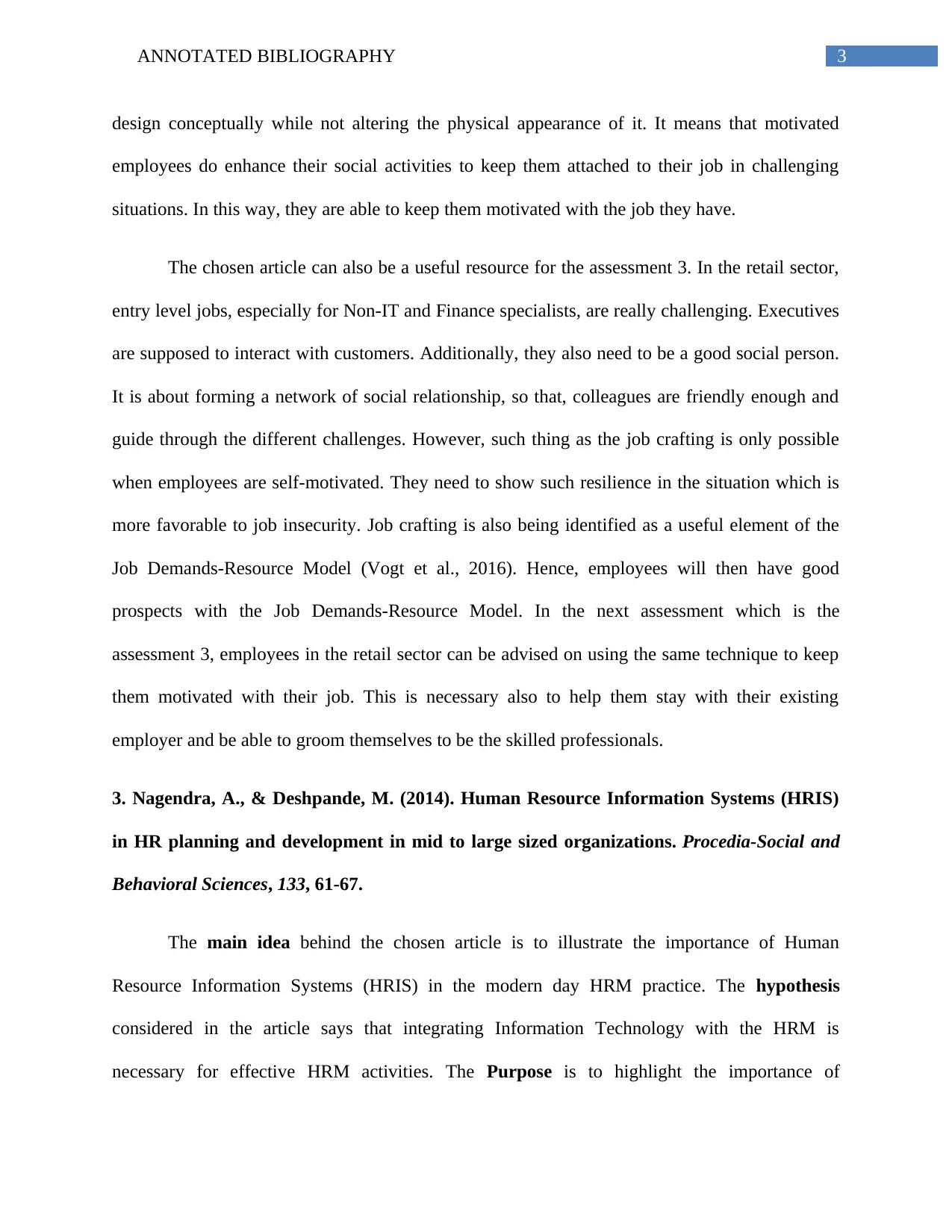
3ANNOTATED BIBLIOGRAPHY
design conceptually while not altering the physical appearance of it. It means that motivated
employees do enhance their social activities to keep them attached to their job in challenging
situations. In this way, they are able to keep them motivated with the job they have.
The chosen article can also be a useful resource for the assessment 3. In the retail sector,
entry level jobs, especially for Non-IT and Finance specialists, are really challenging. Executives
are supposed to interact with customers. Additionally, they also need to be a good social person.
It is about forming a network of social relationship, so that, colleagues are friendly enough and
guide through the different challenges. However, such thing as the job crafting is only possible
when employees are self-motivated. They need to show such resilience in the situation which is
more favorable to job insecurity. Job crafting is also being identified as a useful element of the
Job Demands-Resource Model (Vogt et al., 2016). Hence, employees will then have good
prospects with the Job Demands-Resource Model. In the next assessment which is the
assessment 3, employees in the retail sector can be advised on using the same technique to keep
them motivated with their job. This is necessary also to help them stay with their existing
employer and be able to groom themselves to be the skilled professionals.
3. Nagendra, A., & Deshpande, M. (2014). Human Resource Information Systems (HRIS)
in HR planning and development in mid to large sized organizations. Procedia-Social and
Behavioral Sciences, 133, 61-67.
The main idea behind the chosen article is to illustrate the importance of Human
Resource Information Systems (HRIS) in the modern day HRM practice. The hypothesis
considered in the article says that integrating Information Technology with the HRM is
necessary for effective HRM activities. The Purpose is to highlight the importance of
design conceptually while not altering the physical appearance of it. It means that motivated
employees do enhance their social activities to keep them attached to their job in challenging
situations. In this way, they are able to keep them motivated with the job they have.
The chosen article can also be a useful resource for the assessment 3. In the retail sector,
entry level jobs, especially for Non-IT and Finance specialists, are really challenging. Executives
are supposed to interact with customers. Additionally, they also need to be a good social person.
It is about forming a network of social relationship, so that, colleagues are friendly enough and
guide through the different challenges. However, such thing as the job crafting is only possible
when employees are self-motivated. They need to show such resilience in the situation which is
more favorable to job insecurity. Job crafting is also being identified as a useful element of the
Job Demands-Resource Model (Vogt et al., 2016). Hence, employees will then have good
prospects with the Job Demands-Resource Model. In the next assessment which is the
assessment 3, employees in the retail sector can be advised on using the same technique to keep
them motivated with their job. This is necessary also to help them stay with their existing
employer and be able to groom themselves to be the skilled professionals.
3. Nagendra, A., & Deshpande, M. (2014). Human Resource Information Systems (HRIS)
in HR planning and development in mid to large sized organizations. Procedia-Social and
Behavioral Sciences, 133, 61-67.
The main idea behind the chosen article is to illustrate the importance of Human
Resource Information Systems (HRIS) in the modern day HRM practice. The hypothesis
considered in the article says that integrating Information Technology with the HRM is
necessary for effective HRM activities. The Purpose is to highlight the importance of
Paraphrase This Document
Need a fresh take? Get an instant paraphrase of this document with our AI Paraphraser

4ANNOTATED BIBLIOGRAPHY
Information Systems in HRM activities. The traditional HRM is now being replaced with the
strategic HRM. This was to serve the needs of a changed dimension of the HRM. They are not
just the resource provider but, they are also responsible for much more than that. They need to
use effective strategies driven by technological advancement to achieve and retain the best
talents. The type of research methodology used in this article is both primary and secondary
resources. For primary resources, 50 Senior/Junior HR executives or managers were being
interviewed. Secondary resources are being collected from useful and genuine articles. To
conclude, the human resource management often relies on using the traditional methods instead
of going with the HRIS like e-recruiting. It is for many reasons like insufficient funds and
support from management. The study identifies HRIS as an effective tool to find the unfilled
positions. It is really helpful in HR planning in regards to various working domains of the HRM.
The next assignment which is the assessment 3 will be based on the chosen resource. The
chosen resource may be helpful in analyzing the role of human resource management in context
to HRM planning for the retail industry. Human Resource Information System (HRIS) is a good
prospect now. This can be used for smartly reducing the pressure off from the HRM and also
increasing their efficiency to deliver the best. The various kinds of activities involved in the
HRM planning require a strategy which can reduce the pressure and enhance the effectiveness of
the HRM. They are effective when they are able to find unfilled positions. They are also
effective when they are able to use technology to good causes such as retaining the employees
through an effective employee engagement strategy. In addition to the aforesaid benefits, it can
also promote the hiring of skilled employees. This is indeed necessary to respond to a probable
labor shortage at the global level (Suzdalova, Politsinskaya & Sushko, 2015).
Information Systems in HRM activities. The traditional HRM is now being replaced with the
strategic HRM. This was to serve the needs of a changed dimension of the HRM. They are not
just the resource provider but, they are also responsible for much more than that. They need to
use effective strategies driven by technological advancement to achieve and retain the best
talents. The type of research methodology used in this article is both primary and secondary
resources. For primary resources, 50 Senior/Junior HR executives or managers were being
interviewed. Secondary resources are being collected from useful and genuine articles. To
conclude, the human resource management often relies on using the traditional methods instead
of going with the HRIS like e-recruiting. It is for many reasons like insufficient funds and
support from management. The study identifies HRIS as an effective tool to find the unfilled
positions. It is really helpful in HR planning in regards to various working domains of the HRM.
The next assignment which is the assessment 3 will be based on the chosen resource. The
chosen resource may be helpful in analyzing the role of human resource management in context
to HRM planning for the retail industry. Human Resource Information System (HRIS) is a good
prospect now. This can be used for smartly reducing the pressure off from the HRM and also
increasing their efficiency to deliver the best. The various kinds of activities involved in the
HRM planning require a strategy which can reduce the pressure and enhance the effectiveness of
the HRM. They are effective when they are able to find unfilled positions. They are also
effective when they are able to use technology to good causes such as retaining the employees
through an effective employee engagement strategy. In addition to the aforesaid benefits, it can
also promote the hiring of skilled employees. This is indeed necessary to respond to a probable
labor shortage at the global level (Suzdalova, Politsinskaya & Sushko, 2015).
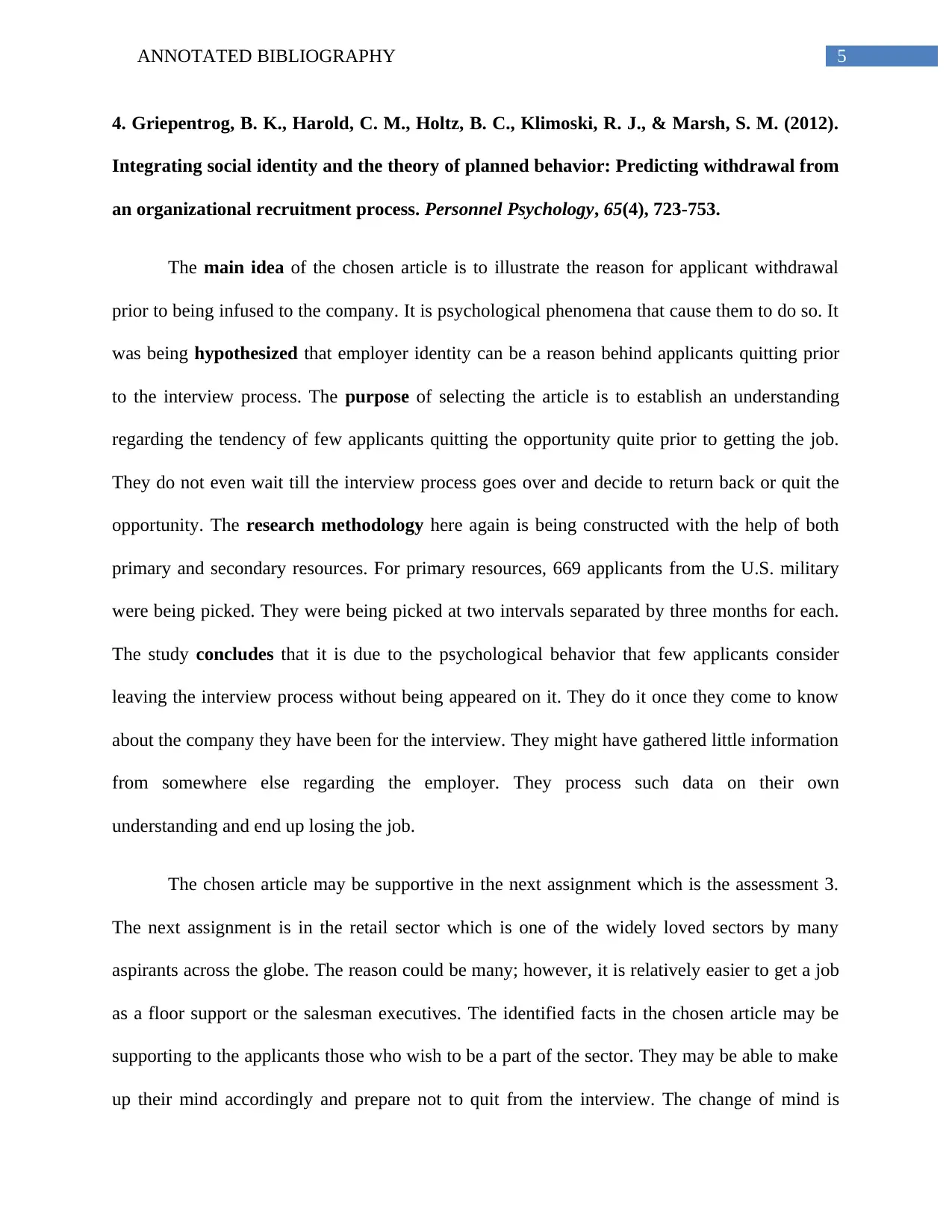
5ANNOTATED BIBLIOGRAPHY
4. Griepentrog, B. K., Harold, C. M., Holtz, B. C., Klimoski, R. J., & Marsh, S. M. (2012).
Integrating social identity and the theory of planned behavior: Predicting withdrawal from
an organizational recruitment process. Personnel Psychology, 65(4), 723-753.
The main idea of the chosen article is to illustrate the reason for applicant withdrawal
prior to being infused to the company. It is psychological phenomena that cause them to do so. It
was being hypothesized that employer identity can be a reason behind applicants quitting prior
to the interview process. The purpose of selecting the article is to establish an understanding
regarding the tendency of few applicants quitting the opportunity quite prior to getting the job.
They do not even wait till the interview process goes over and decide to return back or quit the
opportunity. The research methodology here again is being constructed with the help of both
primary and secondary resources. For primary resources, 669 applicants from the U.S. military
were being picked. They were being picked at two intervals separated by three months for each.
The study concludes that it is due to the psychological behavior that few applicants consider
leaving the interview process without being appeared on it. They do it once they come to know
about the company they have been for the interview. They might have gathered little information
from somewhere else regarding the employer. They process such data on their own
understanding and end up losing the job.
The chosen article may be supportive in the next assignment which is the assessment 3.
The next assignment is in the retail sector which is one of the widely loved sectors by many
aspirants across the globe. The reason could be many; however, it is relatively easier to get a job
as a floor support or the salesman executives. The identified facts in the chosen article may be
supporting to the applicants those who wish to be a part of the sector. They may be able to make
up their mind accordingly and prepare not to quit from the interview. The change of mind is
4. Griepentrog, B. K., Harold, C. M., Holtz, B. C., Klimoski, R. J., & Marsh, S. M. (2012).
Integrating social identity and the theory of planned behavior: Predicting withdrawal from
an organizational recruitment process. Personnel Psychology, 65(4), 723-753.
The main idea of the chosen article is to illustrate the reason for applicant withdrawal
prior to being infused to the company. It is psychological phenomena that cause them to do so. It
was being hypothesized that employer identity can be a reason behind applicants quitting prior
to the interview process. The purpose of selecting the article is to establish an understanding
regarding the tendency of few applicants quitting the opportunity quite prior to getting the job.
They do not even wait till the interview process goes over and decide to return back or quit the
opportunity. The research methodology here again is being constructed with the help of both
primary and secondary resources. For primary resources, 669 applicants from the U.S. military
were being picked. They were being picked at two intervals separated by three months for each.
The study concludes that it is due to the psychological behavior that few applicants consider
leaving the interview process without being appeared on it. They do it once they come to know
about the company they have been for the interview. They might have gathered little information
from somewhere else regarding the employer. They process such data on their own
understanding and end up losing the job.
The chosen article may be supportive in the next assignment which is the assessment 3.
The next assignment is in the retail sector which is one of the widely loved sectors by many
aspirants across the globe. The reason could be many; however, it is relatively easier to get a job
as a floor support or the salesman executives. The identified facts in the chosen article may be
supporting to the applicants those who wish to be a part of the sector. They may be able to make
up their mind accordingly and prepare not to quit from the interview. The change of mind is
⊘ This is a preview!⊘
Do you want full access?
Subscribe today to unlock all pages.

Trusted by 1+ million students worldwide
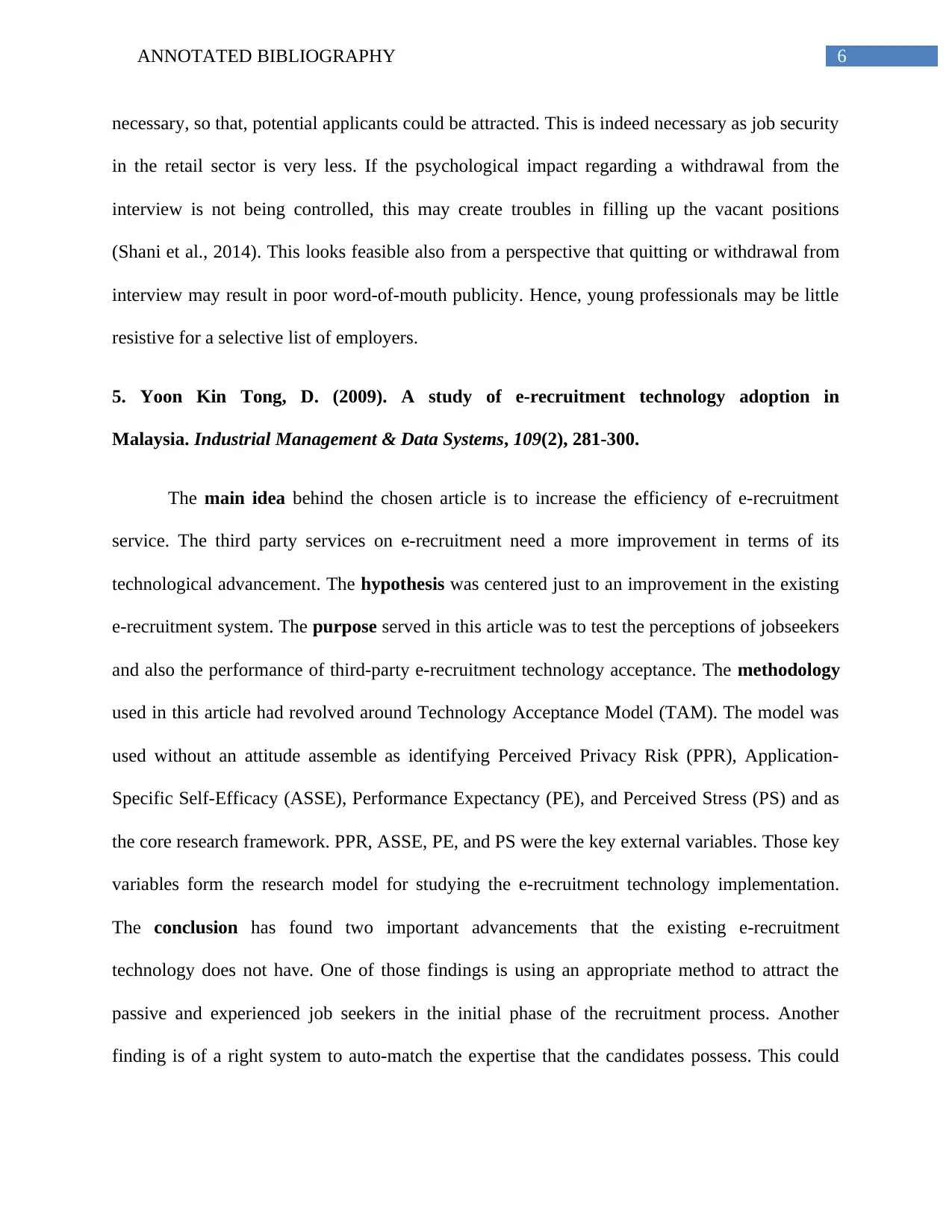
6ANNOTATED BIBLIOGRAPHY
necessary, so that, potential applicants could be attracted. This is indeed necessary as job security
in the retail sector is very less. If the psychological impact regarding a withdrawal from the
interview is not being controlled, this may create troubles in filling up the vacant positions
(Shani et al., 2014). This looks feasible also from a perspective that quitting or withdrawal from
interview may result in poor word-of-mouth publicity. Hence, young professionals may be little
resistive for a selective list of employers.
5. Yoon Kin Tong, D. (2009). A study of e-recruitment technology adoption in
Malaysia. Industrial Management & Data Systems, 109(2), 281-300.
The main idea behind the chosen article is to increase the efficiency of e-recruitment
service. The third party services on e-recruitment need a more improvement in terms of its
technological advancement. The hypothesis was centered just to an improvement in the existing
e-recruitment system. The purpose served in this article was to test the perceptions of jobseekers
and also the performance of third-party e-recruitment technology acceptance. The methodology
used in this article had revolved around Technology Acceptance Model (TAM). The model was
used without an attitude assemble as identifying Perceived Privacy Risk (PPR), Application-
Specific Self-Efficacy (ASSE), Performance Expectancy (PE), and Perceived Stress (PS) and as
the core research framework. PPR, ASSE, PE, and PS were the key external variables. Those key
variables form the research model for studying the e-recruitment technology implementation.
The conclusion has found two important advancements that the existing e-recruitment
technology does not have. One of those findings is using an appropriate method to attract the
passive and experienced job seekers in the initial phase of the recruitment process. Another
finding is of a right system to auto-match the expertise that the candidates possess. This could
necessary, so that, potential applicants could be attracted. This is indeed necessary as job security
in the retail sector is very less. If the psychological impact regarding a withdrawal from the
interview is not being controlled, this may create troubles in filling up the vacant positions
(Shani et al., 2014). This looks feasible also from a perspective that quitting or withdrawal from
interview may result in poor word-of-mouth publicity. Hence, young professionals may be little
resistive for a selective list of employers.
5. Yoon Kin Tong, D. (2009). A study of e-recruitment technology adoption in
Malaysia. Industrial Management & Data Systems, 109(2), 281-300.
The main idea behind the chosen article is to increase the efficiency of e-recruitment
service. The third party services on e-recruitment need a more improvement in terms of its
technological advancement. The hypothesis was centered just to an improvement in the existing
e-recruitment system. The purpose served in this article was to test the perceptions of jobseekers
and also the performance of third-party e-recruitment technology acceptance. The methodology
used in this article had revolved around Technology Acceptance Model (TAM). The model was
used without an attitude assemble as identifying Perceived Privacy Risk (PPR), Application-
Specific Self-Efficacy (ASSE), Performance Expectancy (PE), and Perceived Stress (PS) and as
the core research framework. PPR, ASSE, PE, and PS were the key external variables. Those key
variables form the research model for studying the e-recruitment technology implementation.
The conclusion has found two important advancements that the existing e-recruitment
technology does not have. One of those findings is using an appropriate method to attract the
passive and experienced job seekers in the initial phase of the recruitment process. Another
finding is of a right system to auto-match the expertise that the candidates possess. This could
Paraphrase This Document
Need a fresh take? Get an instant paraphrase of this document with our AI Paraphraser
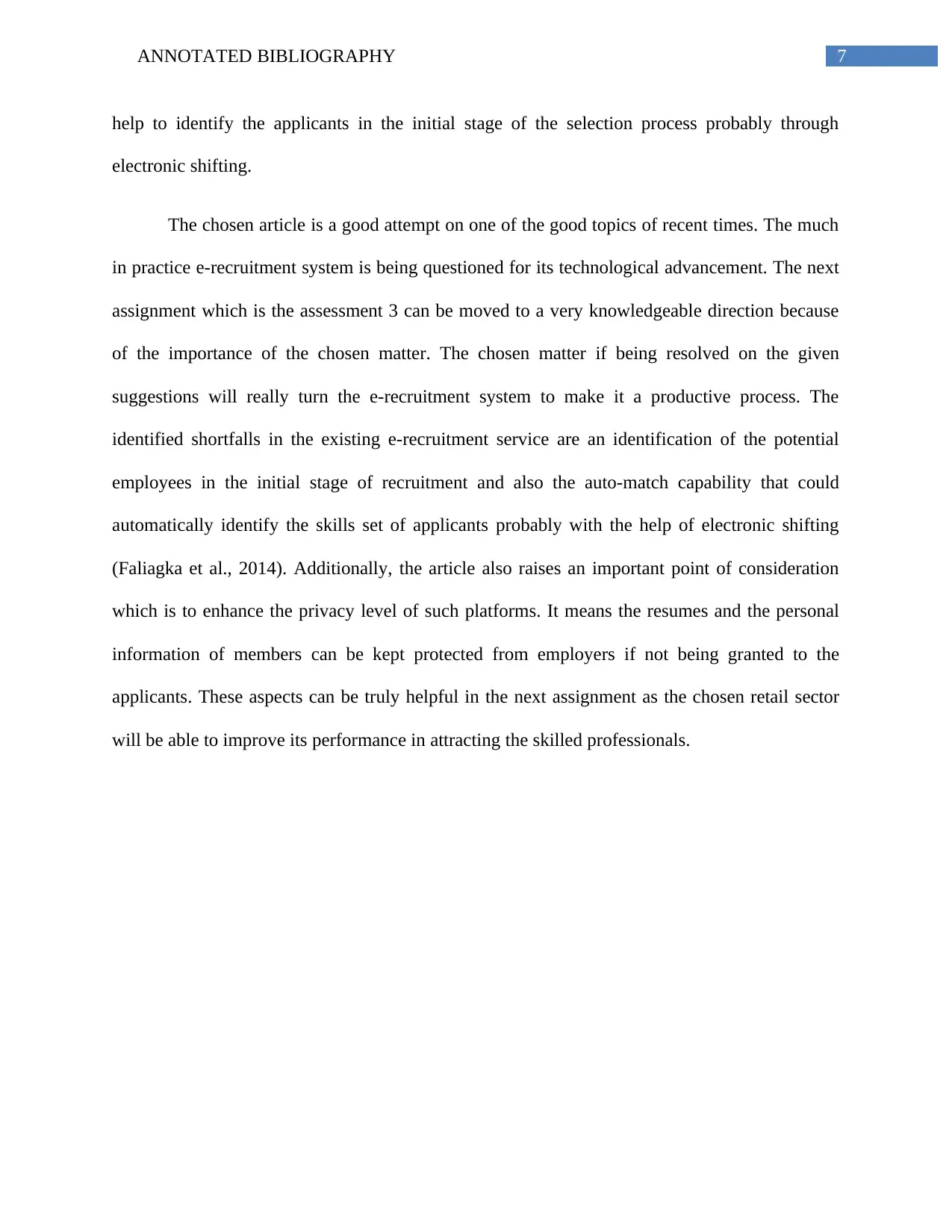
7ANNOTATED BIBLIOGRAPHY
help to identify the applicants in the initial stage of the selection process probably through
electronic shifting.
The chosen article is a good attempt on one of the good topics of recent times. The much
in practice e-recruitment system is being questioned for its technological advancement. The next
assignment which is the assessment 3 can be moved to a very knowledgeable direction because
of the importance of the chosen matter. The chosen matter if being resolved on the given
suggestions will really turn the e-recruitment system to make it a productive process. The
identified shortfalls in the existing e-recruitment service are an identification of the potential
employees in the initial stage of recruitment and also the auto-match capability that could
automatically identify the skills set of applicants probably with the help of electronic shifting
(Faliagka et al., 2014). Additionally, the article also raises an important point of consideration
which is to enhance the privacy level of such platforms. It means the resumes and the personal
information of members can be kept protected from employers if not being granted to the
applicants. These aspects can be truly helpful in the next assignment as the chosen retail sector
will be able to improve its performance in attracting the skilled professionals.
help to identify the applicants in the initial stage of the selection process probably through
electronic shifting.
The chosen article is a good attempt on one of the good topics of recent times. The much
in practice e-recruitment system is being questioned for its technological advancement. The next
assignment which is the assessment 3 can be moved to a very knowledgeable direction because
of the importance of the chosen matter. The chosen matter if being resolved on the given
suggestions will really turn the e-recruitment system to make it a productive process. The
identified shortfalls in the existing e-recruitment service are an identification of the potential
employees in the initial stage of recruitment and also the auto-match capability that could
automatically identify the skills set of applicants probably with the help of electronic shifting
(Faliagka et al., 2014). Additionally, the article also raises an important point of consideration
which is to enhance the privacy level of such platforms. It means the resumes and the personal
information of members can be kept protected from employers if not being granted to the
applicants. These aspects can be truly helpful in the next assignment as the chosen retail sector
will be able to improve its performance in attracting the skilled professionals.
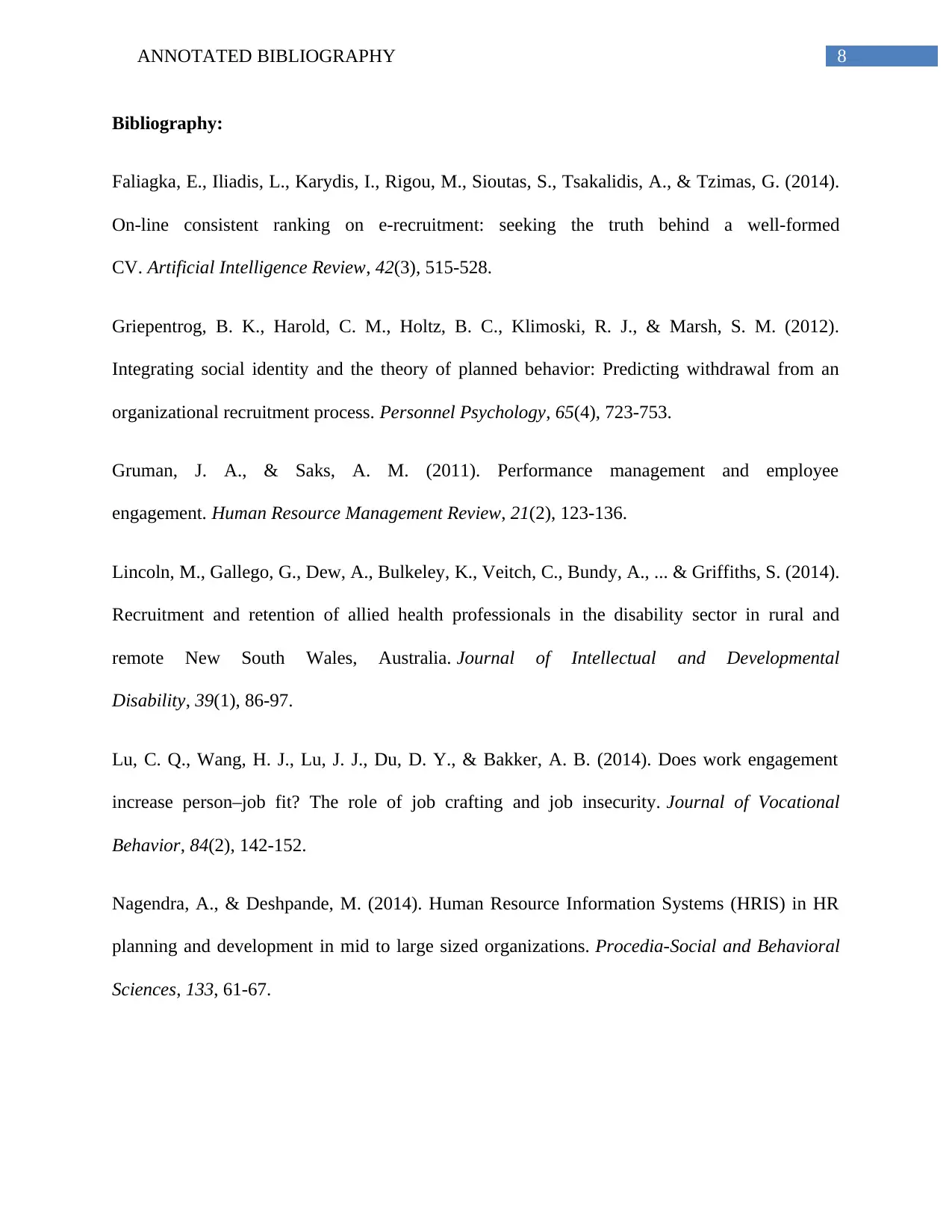
8ANNOTATED BIBLIOGRAPHY
Bibliography:
Faliagka, E., Iliadis, L., Karydis, I., Rigou, M., Sioutas, S., Tsakalidis, A., & Tzimas, G. (2014).
On-line consistent ranking on e-recruitment: seeking the truth behind a well-formed
CV. Artificial Intelligence Review, 42(3), 515-528.
Griepentrog, B. K., Harold, C. M., Holtz, B. C., Klimoski, R. J., & Marsh, S. M. (2012).
Integrating social identity and the theory of planned behavior: Predicting withdrawal from an
organizational recruitment process. Personnel Psychology, 65(4), 723-753.
Gruman, J. A., & Saks, A. M. (2011). Performance management and employee
engagement. Human Resource Management Review, 21(2), 123-136.
Lincoln, M., Gallego, G., Dew, A., Bulkeley, K., Veitch, C., Bundy, A., ... & Griffiths, S. (2014).
Recruitment and retention of allied health professionals in the disability sector in rural and
remote New South Wales, Australia. Journal of Intellectual and Developmental
Disability, 39(1), 86-97.
Lu, C. Q., Wang, H. J., Lu, J. J., Du, D. Y., & Bakker, A. B. (2014). Does work engagement
increase person–job fit? The role of job crafting and job insecurity. Journal of Vocational
Behavior, 84(2), 142-152.
Nagendra, A., & Deshpande, M. (2014). Human Resource Information Systems (HRIS) in HR
planning and development in mid to large sized organizations. Procedia-Social and Behavioral
Sciences, 133, 61-67.
Bibliography:
Faliagka, E., Iliadis, L., Karydis, I., Rigou, M., Sioutas, S., Tsakalidis, A., & Tzimas, G. (2014).
On-line consistent ranking on e-recruitment: seeking the truth behind a well-formed
CV. Artificial Intelligence Review, 42(3), 515-528.
Griepentrog, B. K., Harold, C. M., Holtz, B. C., Klimoski, R. J., & Marsh, S. M. (2012).
Integrating social identity and the theory of planned behavior: Predicting withdrawal from an
organizational recruitment process. Personnel Psychology, 65(4), 723-753.
Gruman, J. A., & Saks, A. M. (2011). Performance management and employee
engagement. Human Resource Management Review, 21(2), 123-136.
Lincoln, M., Gallego, G., Dew, A., Bulkeley, K., Veitch, C., Bundy, A., ... & Griffiths, S. (2014).
Recruitment and retention of allied health professionals in the disability sector in rural and
remote New South Wales, Australia. Journal of Intellectual and Developmental
Disability, 39(1), 86-97.
Lu, C. Q., Wang, H. J., Lu, J. J., Du, D. Y., & Bakker, A. B. (2014). Does work engagement
increase person–job fit? The role of job crafting and job insecurity. Journal of Vocational
Behavior, 84(2), 142-152.
Nagendra, A., & Deshpande, M. (2014). Human Resource Information Systems (HRIS) in HR
planning and development in mid to large sized organizations. Procedia-Social and Behavioral
Sciences, 133, 61-67.
⊘ This is a preview!⊘
Do you want full access?
Subscribe today to unlock all pages.

Trusted by 1+ million students worldwide
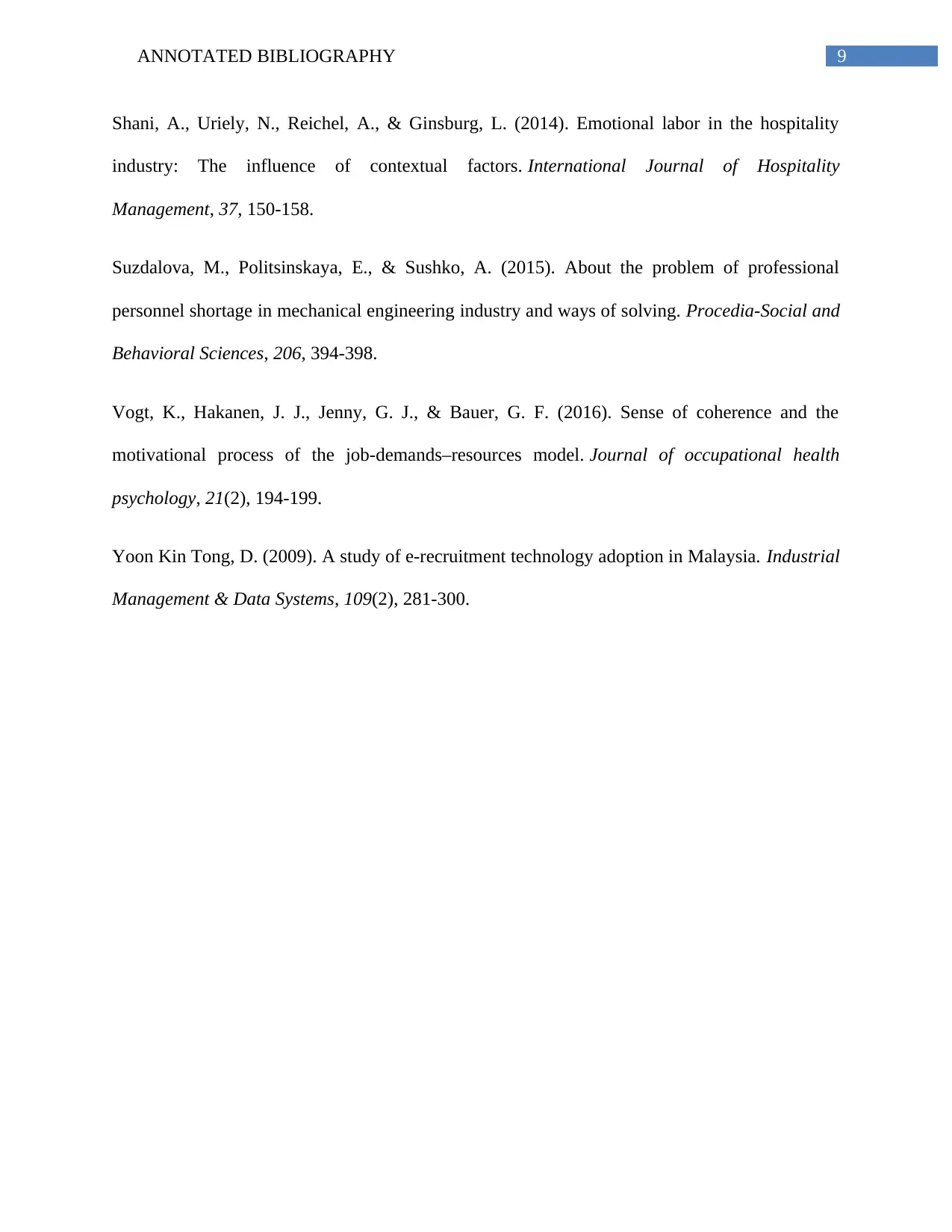
9ANNOTATED BIBLIOGRAPHY
Shani, A., Uriely, N., Reichel, A., & Ginsburg, L. (2014). Emotional labor in the hospitality
industry: The influence of contextual factors. International Journal of Hospitality
Management, 37, 150-158.
Suzdalova, M., Politsinskaya, E., & Sushko, A. (2015). About the problem of professional
personnel shortage in mechanical engineering industry and ways of solving. Procedia-Social and
Behavioral Sciences, 206, 394-398.
Vogt, K., Hakanen, J. J., Jenny, G. J., & Bauer, G. F. (2016). Sense of coherence and the
motivational process of the job-demands–resources model. Journal of occupational health
psychology, 21(2), 194-199.
Yoon Kin Tong, D. (2009). A study of e-recruitment technology adoption in Malaysia. Industrial
Management & Data Systems, 109(2), 281-300.
Shani, A., Uriely, N., Reichel, A., & Ginsburg, L. (2014). Emotional labor in the hospitality
industry: The influence of contextual factors. International Journal of Hospitality
Management, 37, 150-158.
Suzdalova, M., Politsinskaya, E., & Sushko, A. (2015). About the problem of professional
personnel shortage in mechanical engineering industry and ways of solving. Procedia-Social and
Behavioral Sciences, 206, 394-398.
Vogt, K., Hakanen, J. J., Jenny, G. J., & Bauer, G. F. (2016). Sense of coherence and the
motivational process of the job-demands–resources model. Journal of occupational health
psychology, 21(2), 194-199.
Yoon Kin Tong, D. (2009). A study of e-recruitment technology adoption in Malaysia. Industrial
Management & Data Systems, 109(2), 281-300.
1 out of 10
Related Documents
Your All-in-One AI-Powered Toolkit for Academic Success.
+13062052269
info@desklib.com
Available 24*7 on WhatsApp / Email
![[object Object]](/_next/static/media/star-bottom.7253800d.svg)
Unlock your academic potential
Copyright © 2020–2025 A2Z Services. All Rights Reserved. Developed and managed by ZUCOL.





